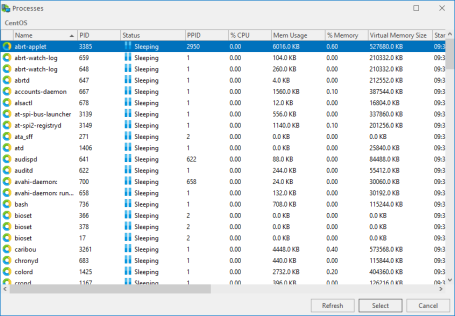Linux Process Monitor
The Linux Process Monitor is used to monitor all processes running on the Linux system. Processes can be monitored by Process Name, Process Owner or Process Identification Number (PID). You can select to generate alerts based on whether the process does or does not exist or if it is triggered by the rule criteria.
When you specify the instance of the Process to which this rule criteria applies, you can enter a full path to the required instance or use Wildcards ‘*’ and ‘?’ to create a generic entry. Regular expressions can also be entered by changing the entry in the first drop down choice menu from Wildcard to Regex and entering a valid Regular Expression in the second drop-down choice menu.
Using wildcards and regular expressions allow you to create generic rules that can then be included in a template in order to monitor multiple systems.
Adding Linux Process rule criteria
- From the Linux system in the Systems panel of Central Configuration Manager, select Linux Process Monitor and click Add Rule.
- From the Add Rule Detail dialog, click Criteria. Click Add Criteria to open the Process Criteria dialog.
Rapid Method
- From the Process Criteria dialog click Browse to open the Processes dialog, listing all the subsystems and status information.

- Click on a process to highlight and then click Select.
In-depth Method
There are three pages to complete when adding Linux Process rule criteria.
Category section
This section defines how the process is selected.
Monitor Type
Use the drop-down menu to define the type of process to be monitored for the rule:
- Process by PID: The named Process Identifier (PID) is monitored.
- Process by Name: The process is monitored by name.
- Process by Owner: The process is monitor by owner.
Alert If
From the drop-down menu select the method by which an alert is triggered for this rule.
- Process Exists: An alert is triggered if the process exists.
- Process Does Not Exist: An alert is triggered if the process does not exist.
- If Criteria Triggers: An alert is raised if other criteria for this rule are triggered.
Instance section
This section defines how process name or owner is defined. If the Monitor Type is Process by PID, enter the PID into the Instance field
Process Name (Owner)
Use the drop down menu to select whether the process name or owner is defined by the use of wildcards '*' and '?' or by Regular Expression (Regex).
Trigger section
This section defines the unit of measure and how actions are performed.
Measure
Use the drop-down menu to determine how the criteria is measured for this process rule.
- CPU Usage %: The selected process is measured against Used CPU %.
- Cumulative CPU Time: The selected process is measured against Cumulative CPU Time used (in seconds).
- Number of Processes: The selected process is measured against the number of this process running,
- Process Physical Memory Used %: The selected process is measured against the amount of physical memory used expressed as a percentage.
- Process Physical Memory Used: The selected process is measured against the actual amount of process physical memory used
- Elapsed Time: The selected process is measured against an elapsed time period which can be defined as seconds, minutes or hours
- Virtual Memory Size: The selected process is measured against the Virtual Memory Size, which can be defined in Bytes, Kilobytes, Megabytes or Gigabytes.
Trigger Value
Specify a comparator, value and if available for the selected measure the unit value fro the threshold.
Perform Actions For:
If the criteria is set to perform actions for the first triggered instance, any resulting alert contains a summary of the instances that breached the criteria threshold. If it is set to perform actions for all triggered instances, then an alert is raised for each instance containing only details of that particular instance.
Criteria Alert Details section
Fields in this section define alert settings that override the settings made on the Alert page at Rule level. This provides a criteria specific alert message to be generated.
Override Rule Default
Click Override Rule Default to specify that the entries on this page override the default Alert page settings at Rule level. From the drop-down menu, select the alert warning level.
Alert Text
Enter the actual text of the alert or use the available Substitution Variables to construct the message text of the alert.
Alert Example
Displays an example of how the Alert Text will read using the selected Substitution Variables and user-entered text.
SLA Statistic section
Fields in this section are used to indicate that the criteria for this rule are used to determine performance against Service Level Agreements (SLA).
SLA Statistic
Click the SLA Statistic field so that it is enabled. The SLA flag is measured against the specific criteria defined for this rule.
We recommend that when creating SLA flags within rules, that all SLA criteria are kept together in the same rule that use the ‘Perform Actions For Each Criteria That Triggers option, otherwise SLA failures may or may not be indicated correctly.
System performance against the specified SLA flags can then be viewed on the SLA Statistics report (automatically included as a Report Template within Advanced Reporting Suite) for this system.
Ignore Instances section
This field is used to define any instances that can be ignored by the rule.
Click Add to open the Add Instance dialog. Type the name of the instance to be ignored and click OK. Wildcards '*' and '?' can be used to create the entry. Multiple ignored instances can be added to a single rule.
Testing
Once the Subsystem parameters have been defined for the criteria, click Test to ensure that the returned results are the same as would be expected if the rule was live.
Click OK to confirm the entered parameters as criteria for this rule.